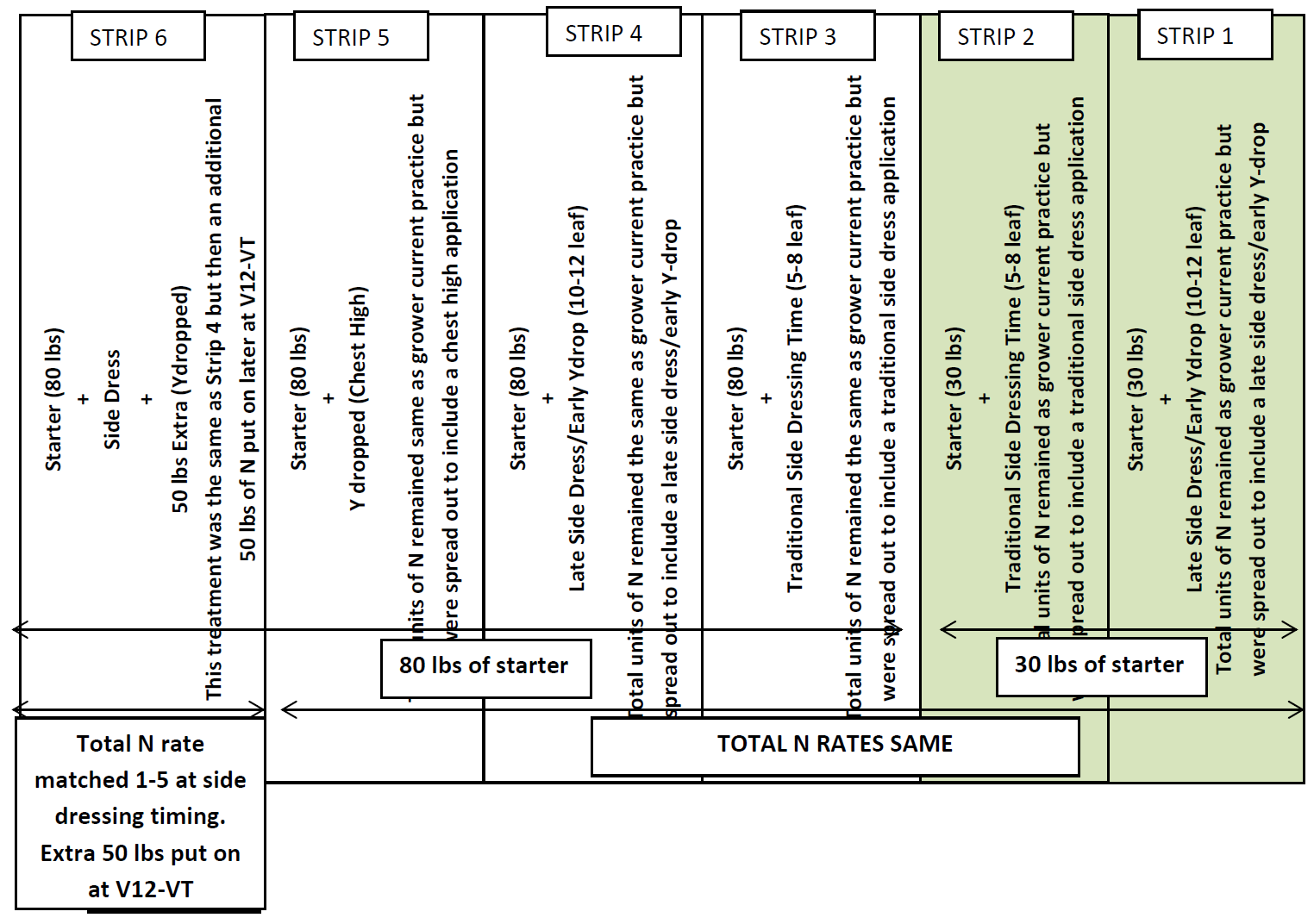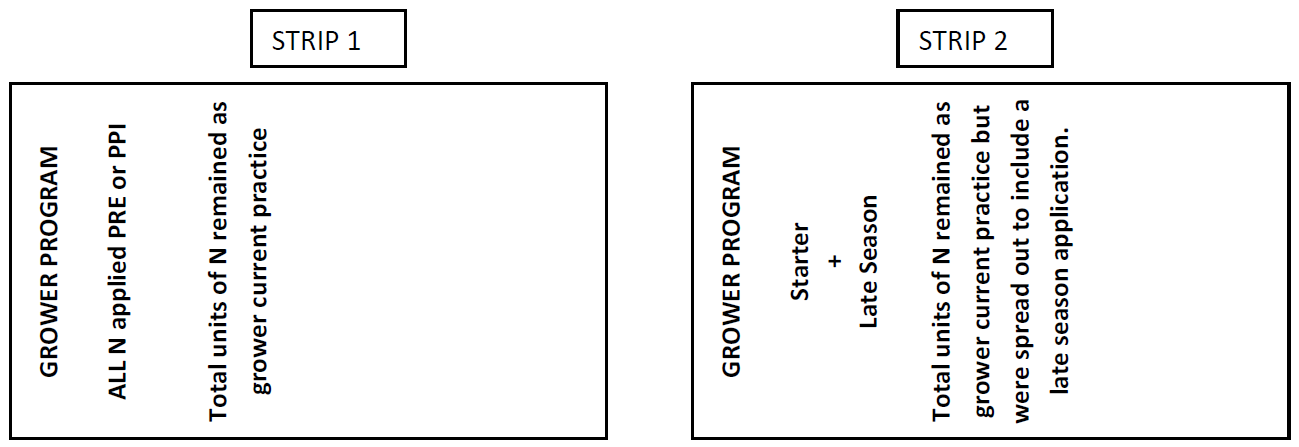Background
Corn takes up 80% of its total N requirement after the traditional side dressing time of 8 leaf corn.
As modern hybrids require more N later in the season and the industry moves towards pushing corn yields to upper limits, one of the more frequent questions that come up is: Can growers be more efficient with units of N if they move the application period out to coincide with greatest plant uptake? Secondly, we have experienced greater swings in major weather events in the last 5-8 years which begs the question what is happening to the N in the soil during extreme wet and dry periods. Therefore is it possible to reduce the environmental risk of losing N by applying it in greater quantity to coincide with the highest uptake period.
Current grower nitrogen application timing strategies have been either (a) all up front in the form of straight dry or a dry and liquid combination or (b) a combination dry and liquid up front plus a side dressing application. Norfolk county consists of highly variable sandy soils, where N placement and application timing is crucial for optimal crop growth.
Project Design
2 separate N application studies were designed to address the background questions described above. The 2 studies had specific purposes and objectives with the goal to breakdown the complexity of N application in corn to (1) N timing (2) N placement (3) N rate.
The 2 studies also aimed to address all of Norfolk Counties current grower practices, so any grower using any current N strategy will be able to use the information/data to make management decisions.
Corn N - Study 1
Purpose
Study the effects of N uptake on corn growth and yield.
Objectives
- Compare how lower vs higher rates of N Pre Plant effect corn yield and growth.
- Examine how lower vs higher Pre N rates interact with corn growth and yield with later season applications.
- Examine how incremental units of N in combination with a late season application impacts corn yield and growth.
Background
The trial was as a full field scale project with 6 treatments (see diagram below)
Treatment 1 – Growers current N rate – included a starter (30 lbs-Max) + Side dress (5-8 leaf) – Total N rates matched treatment 2,3,4,5 at the end of the side dressing.
Treatment 2 – Growers current N rate –included a starter (30 lbs-Max) + Late side (10-12 leaf) dress/early Y-drop – Total N rates matched treatment 1,3,4,5 at the end of the late side dressing/early Y-drop.
Treatment 3 – Growers current N rate –included a starter (80 lbs -Minimum) + Side dress (5-8 leaf) – Total N rates matched treatment 1,2,4,5 at the end of the side dressing.
Treatment 4 – Growers current N rate – included a starter (80 lbs -Minimum) + Late side dress/early Y-drop (10-12 leaf) – Total N rates matched treatment 1,2,3,5 at the end of the late side dressing/early Y-drop.
Treatment 5 – Growers current N rate – included a starter (80 lbs -Minimum) + Y drop at approximately chest high – Total N rates matched treatment 1,2,3,4 at the end of the Y-drop application.
Treatment 6 – Growers current N rate – included a starter (80 lbs -Minimum) + Side dress application (5-8 leaf) – Total N rates matched treatment 1,2,3,5 at the end of the side dress application. An additional 50 lbs of N was applied at V12-VT.
DIscussion of 2017 Results
- Where a higher amount of dry starter was used at planting and side dressed at the traditional 5-8 leaf timing, corn yields tended to be higher.
- Where a high rate of dry starter was used at planting there was no yield disadvantage to waiting to apply N at a later side dressing timing.
- Where a low rate of dry starter was used at planting there appeared to be a slight yield disadvantage to waiting to apply the second application of N until later.
- When the second N application was made at chest high corn in 2 of the 3 locations a yield loss was observed.
- Corn yields were highest in 2 of the 3 locations where a third N application was made close to VT with an extra 50 lbs of N.
3 Year N Study Trends
- Early season N availability appears to be an important factor for corn growth and yield. In all 3 years across many sites we observed yield losses where N application was delayed in split application treatments.
- Where extra N was applied above the standard grower use rate at the VT timing, a numerical yield advantage was observed 75% of the time over the growers standard N program.

Results - Corn Yields

Corn N - Study 2
Purpose
Study the effects on corn growth and yield with the application of nitrogen later in season, closest to the time of greatest plant uptake.
Objectives
Compare current grower programs of entire N application upfront vs split application to include a late season N application.
Discussion of Results
- A split application of N increased yields significantly over applying all the N up front in a single application.
- There was no significant difference between 45 or 50 gallons of UAN applied pre plant.
- The addition of 15 gallons of N (45 lbs) applied over the standard rate of N increased yields by 14 bu in the second site.
The committee would like to recognize the support of the Ontario Ministry of Food and Rural Affairs and the Ontario Soil and Crop Improvement Association of this project through a Tier One Grant. Thank you also to the cooperators who participated in the trials.

Yield Results - Application Timing

Yield Results - Rate of N
*Yields are reported in bu per acre, PPI = preplant incorporated, location was corn following winter wheat.

